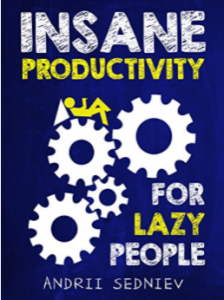Friday Feature: Insane Productivity Hacks For Lazy People
Originally published by Maria Riegger on June 23, 2020
Today I’d like to share with you some fantastic tips from the book Insane Productivity for Lazy People by Andrii Sedniev.
 The main thing I love about this book is that it gives the reader practical tips that you can implement immediately. I’ve been using one of his hacks for the past week, and have been pleased with how much I’ve been able to get done.
The main thing I love about this book is that it gives the reader practical tips that you can implement immediately. I’ve been using one of his hacks for the past week, and have been pleased with how much I’ve been able to get done.
I highly recommend that you read the entire book; it’s a fast read and the eBook version currently costs only $3.97 on Amazon. Sedniev makes several recommendations that I’ve discussed on this blog, including the importance of setting goals and focusing on less in order to do more. That is, do not get wrapped up in inconsequential tasks that have little to no value. As Sedniev emphasizes, being “busy” is NOT the same as being “productive.” Below I’ve shared with you some of his tips:
Turn off multitasking.
The ability to multitask is a myth. You may be able to, for example, wash a few dishes while food is cooking on the stove (which I do frequently), but it is not possible to give the same level of attention to two important tasks. When you’re working on an important task, whether it’s writing an article or designing a webpage, focus on the task at hand. Give your total attention to the task you are doing. The quality of your work suffers when you ‘multitask.’ Further, every time you take your attention off of one task and focus on a different task, your concentration is impaired and your energy is drained. Switching back and forth between different tasks uses more energy than focusing on only one task for the same period of time.
Use what Sedniev calls the School Bell Technique.
This technique is great for people like me who need carrots and things to look forward to after completing tasks. The technique is this: work on a task for 45 minutes, giving it your full attention, then take a 5-minute break. Next, work for another 45 minutes, then take a 15-minute break. Continue to work for 45-minute blocks alternating your time for breaks. In this manner, you are better able to focus because you know you only have 45 minutes, and that you will soon be able to take a break. Often, the most difficult thing about completing a task is initiating the task. Once you get started, you are on a roll.
Here are things that you can do during breaks: read fiction or a magazine (read something that you want to read, not something that you think you should read); step outside and get fresh air; play with your pet; do stretches; take a walk; look out the window; talk to your partner or kids, etc. You need to take your attention away from the task for a few minutes to refocus.
What not to do during breaks: watch television or Internet videos, play video games, scroll your phone, etc. These activities do not re-energize you. You need to give your eyes and brain a break from the screen. Instead, you can do these things AFTER you’ve accomplished your tasks for the day.
In addition to working in 45-minute blocks with regular breaks, Sedniev recommends that you take one to two days off per week, and one week off per month to recharge your energy. Use that time to do things that you enjoy and to rest your brain. As we discussed in my post on the book Switch: How to Change Things when Change is Hard, concentration and willpower are exhaustible resources. Humans are not machines; we need mental breaks.
I’ve been using the School Bell Technique for the past week, and it works. The most difficult part for me is getting started. Once I begin a task, I almost always complete it. Time your work periods and take your breaks, then spend the rest of the day doing whatever you want to do.
Prioritize those tasks that give you the best results.
First, Sedniev recommends reducing the quantity of tasks on which you work. Focus on less in order to do more. When we are mentally scattered, we don’t accomplish much. Further, he notes that approximately 20% of tasks bring 80% of results. Outsource those tasks that don’t bring much value. This is the reason why I outsource cleaning my house. In the amount of time it takes to deep clean my house, I can accomplish tasks that bring financial and other value to my life. It also saves my energy so that I can better focus on those important business – and family – related tasks.
Every evening, write a plan of tasks that you intend to accomplish the next day.
Prioritize those tasks in order of value that they will bring; do the most important tasks first. The act of writing them down helps you to remember (now you don’t have to spend energy trying to remember what you wanted to do); and it brings them out of your consciousness into reality. That may sound weird, but the act of stating that you will do something makes you more likely to do it. It holds you accountable because you’ve indicated that you will do it.
Visualize what you want to accomplish.
Almost every productivity guru makes a similar statement, and it’s true. If you can dream it, and you believe that you can accomplish it, then you can accomplish it. When I turned 40 years old, some people depressingly mentioned that 40 was the beginning of the end, it’s middle age, etc. I told them, “Hey, if you believe that 40 is the end, and that life won’t get better, then for you, it won’t.” As an aside, don’t hang out with negative people like that; they just hold you back. On this note, if you read about the Law of Attraction, you will see that it suggests that you attract into your life what you give your time and attention to. Productivity begets more productivity; and lethargy begets more lethargy. Further, the Law suggests that if you do not think that something is possible, then it won’t be. Simple as that.
I hope that has been helpful for you! I highly recommend the book and encourage you to try the School Bell Technique. Let me know how it goes for you!
Being busy is not the same as being productive.




